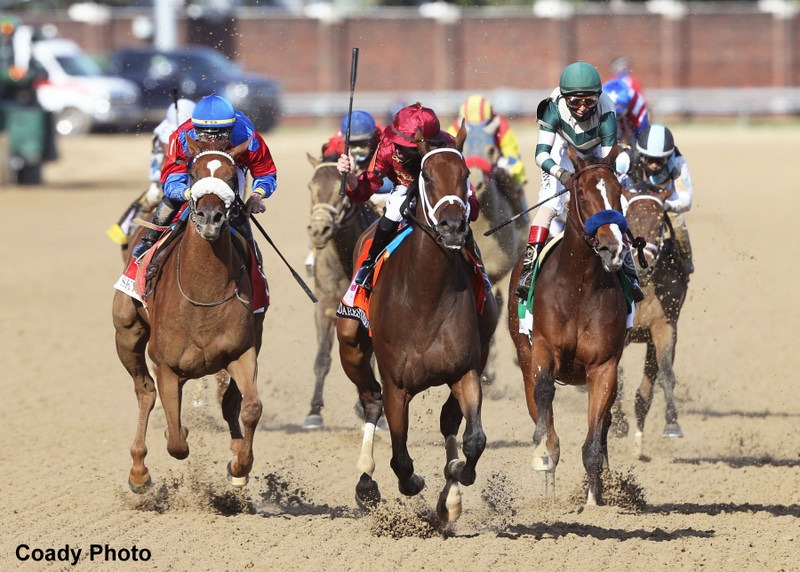
By rule The Kentucky Horse Racing Commission is not permitted to reveal the identity of a horse or its trainer with a pending positive test until after its investigation is complete. A second test or split sample is taken as part of the investigation. Despite that rule reports began to circulate throughout social media, specifically on Twitter and within the horse racing community, a horse in the Kentucky Oaks had tested positive for a Class C medication and that the horse was Gamine and the trainer was Bob Baffert. This was similar to what happened in Arkansas at Oaklawn Park when Charlatan and Gamine tested positive for lidocaine reportedly as a result of a contaminated patch worn by assistant trainer Jimmy Barnes. There is a similar rule in Arkansas calling for the name and identity of a horse and trainer not to be released until the split sample is returned and the investigation is complete.
Joe Drape of The New York Times reported Thursday that Gamine was the source of the positive test, noting it was the second time this year she had tested positive for a “banned substance.” Drape cited two unnamed sources. Multiple reports followed The Times identifying the horse and trainer. That led to Bob Baffert addressing the issue.
He released the following statement through his attorney W. Craig Robertson:
The current reporting on Gamine is inaccurate and needs to be cleared up. First, Betamethasone is a legal, commonly used anti-inflammatory medication. It is not a “banned substance.” Second, the medication was administered to Gamine on Aug. 17 by her veterinarian and on the veterinarian’s recommendation. Importantly, the veterinarian followed established medical and regulatory guidelines in administering the medication. The withdrawal guidelines published by the Kentucky Horse Racing Commission recommend that the medication not be given within 14 days of a race. In this instance, as an additional layer of protection, Gamine’s veterinarian last treated her with betamethasone 18 days before the Oaks.
Gamine’s test revealed 27 picograms of betamethasone. The current threshold in Kentucky is 10 picograms. The situation with Gamine highlights two issues that are very troubling and must be addressed by the racing industry. First, the thresholds for many lawful medications such as betamethasone are way too low. A picogram is a trillionth of a gram. Twenty-seven picograms is a minuscule amount that would not affect a 1,000-pound animal. The regulations governing racing must be ones that are related to pharmacology in a horse as opposed to how sensitive labs can test. Second, trainers and veterinarians must be able to rely on guidelines given them by racing officials. If they are told by regulators that a medication will clear a horses system in 14 days, they must be able to rely on that information.
It is easy to confuse and intertwine the issues at hand here.
First, if the rules call for not naming the horse or connections until the investigation is complete, why are those not followed by at least two jurisdictions? Is it coincidence in both cases the “leak” involves the same trainer?
If you don’t agree with the rule, change it. Allow all test results to be public knowledge and transparent. The call for transparency does not give racing jurisdictions the carte blanche decision to follow or not follow a rule depending on who the test result involves or any other criteria they may have. What surely should never happen is a rule being ignored to fuel rumors and inaccurate information.
As a bettor, fan, and student of the game I would be in favor of knowing the results of any positive test and not having to wait for split sample results. I think this is especially true if wagering on these horses when they race subsequent to positive tests. Unfortunately, that is not the current rule, and I am not in favor of selective or targeted enforcement, or skirting the rules to suit yourselves. This weak attempt at transparency actually makes the water much more murky.
Next, if a drug has a 14 day threshold to clear the system, and that protocol is followed and documented, and a test result finds trace amounts of the drug, picograms in this case which are minuscule, that should be considered as part of the investigation and in any ruling.
Thresholds are obviously not an exact science. Metabolism and other factors affect withdrawal times. This should also be considered when establishing rules and protocols. How as an industry do we set examples and penalize those who followed the rules and had a positive test but at the same time allow trainers who skirt or ignore the rules to continue unscathed? Remember we don’t test for what we don’t know is being used.
When laboratories or racing authorities leak limited information it feeds rumors and rumors do no good for an already struggling sport. I say do some good, don’t add nails to the coffin.
This is what was found in Gamine in a minuscule amount according to the statement:
BetaVet® is the only FDA-approved dual ingredient injectable corticosteroid for use in horses.
In the medical management of OA by equine practitioners, intra-articular corticosteroids such as BetaVet® (betamethasone sodium phosphate and betamethasone acetate injectable suspension), are considered a cornerstone of therapy to reduce inflammation.
BetaVet® is the first dual-action betamethasone product proven safe and effective in horses.
Target animal safety (TAS) study2 supported the FDA approval of BetaVet® when administered IA to horses in a maximum of two joints at a one-time dosing of 9 mg per joint.
Thursday saw the rumors racing faster than the horses as a result of information that according to the current rule, should not have been public.
Here are a few of them.
Gamine was positive for a performing enhancing drug in the Kentucky Oaks.
Bob Baffert was going to replace his entire staff because he was being sabotaged.
Authentic could have never beaten Tiz the Law without performing enhancing drugs.
The Gamine positive was going to be covered up to protect Bob Baffert.
The Gamine positive was going to result in Bob Baffert being banned.
Bob Baffert’s horses won’t be allowed to run in the Breeders’ Cup.
This is the type of chatter leaking partial information prematurely led to with just over two weeks to the Breeders’ Cup. Is this transparency? Is this good for the integrity of the sport? Is The Times article fair and accurate reporting? They went with the article based on unnamed sources who apparently told them some of the story but not what drug it was?
If nothing else this is a further example of why our industry needs the Horse Racing Safety and Integrity Act. We fail miserably to police, regulate, and govern ourselves, especially when it comes to drugs, illegal and otherwise. Let’s not forget it took the FBI to indict trainers for using performance enhancing drugs and killing horses while many in the industry sat back and watched at all our expense, let alone the horses. We need the uniformity, correct protocols, enforcement, and at the end of the day as close to no drugs as is conceivable or possible. What we don’t need are rumors, innuendos, hit pieces, slander and gossip. As Detective Joe Friday would say;
“just the facts ma’am”
Photo; Kentucky Oaks, Coady Photography



